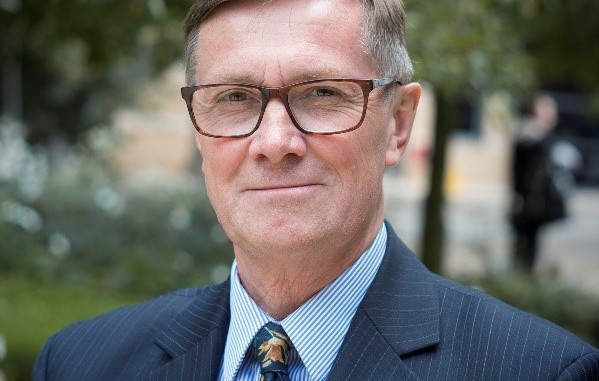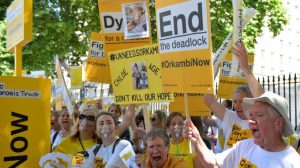
The evening of the 12 June saw me at the Terrace Pavilion of the House of Commons, having been invited by Baroness Nicola Blackwood of North Oxford (Parliamentary Under Secretary of State at the Department of Health and Social Care) to celebrate NICE’s 20th Anniversary. Those of you who attended the joint London CLAHRCs breakfast back in 2017 would have recognised the venue on the banks of the Thames overlooking St Thomas’ Hospital. However, this was to be a wet and grey evening, as opposed to the dry and sunny morning in 2017.
We were welcomed by Sir Andrew Dillon, Chief Executive of NICE for 20 years (surely a record for any NHS institution) and introduced to the speakers. The programme had announced that the first speaker was to be the current secretary of state (SoS) Matt Hancock (the 10th SoS since NICE was launched by Frank Dobson on 1 April 1999 – who by the way, when asked at the beginning whether he felt NICE would succeed responded with “probably not, but we will give it a bloody good try”). Nor surprisingly as one of the candidates aiming to be the next Prime Minister the SoS had other things to do that evening (however, since then he has withdrawn from the race and is currently supporting Boris Johnson.)
So our host, Baroness Nicola Blackwood, stepped in and demonstrated very eloquently why politicians value NICE having to make difficult health prioritisation decisions. As the first chairman of NICE Sir Michael Rawlins had previously, pithily, said when asked in an interview whether politicians had ever interfered with NICE: “There was no attempt at all to interfere, actually, ministers realised the value of having us, as it were, as a fig leaf for them − the ‘blame quango’”. Next on was Sir Simon Stevens, Chief Executive of NHS England, heralded as being at the conception of NICE when he was health policy adviser to Tony Blair. Like the Baroness before him, he not only praised NICE, but acknowledged the influence of Sir Andrew Dillon. He covered the full span of NICE from its origins as a Department of Health response to judicial review against the government limiting the availability of Viagra on the NHS, right up to current times. We were told that his recommendation to the Trump administration who were complaining about the cheapness of drugs in the UK compared to the USA was, of course, to get a NICE. Politically astute, as ever, he praised the politicians for supporting the concept of assessing value for money based on evidence. He finished up, however, with an observation on NICE that I thought was very thoughtful. He concluded with the comment that the government could have populated NICE with moral philosophers, but decided not to. He then suggested that Sir Andrew looked like a moral philosopher – wise and calm under pressure. I have heard Andrew being called many things over the years but a moral philosopher is a new one. It was good to hear the public recognition that NICE decisions had an ethical content, which required social values to be addressed.
For those who are not moral philosophers, moral philosophy is the branch of philosophy that contemplates what is right and wrong. It explores the nature of morality and examines how people should live their lives in relation to others. It has three branches: meta-ethics, which investigates big picture questions such as “What does it mean to call something just?”. The second branch is called normative ethics. It focuses on providing a framework for deciding what is right and wrong. Three common frameworks are deontology, utilitarianism, and virtue ethics. The last branch is applied ethics. It addresses specific, practical issues of moral importance, such as euthanasia. So, whether the moral focus is big picture questions, a practical framework, or applied to specific dilemmas, moral philosophy can provide the tools we need.
The next speaker was Mike Thompson, Chief Executive of the Association of the British Pharmaceutical Industry who explored the industry’s response to NICE over the years from the days of its first appraisal – saying ‘No’ to Relenza (an anti-influenza drug, and equivalent ones, whose worth is still hotly debated) to today’s resigned co-habitation. He concluded with the view that NICE and the industry look forward to working harmoniously together – however more of this later. Listening to him I was reminded of the poem “Jim” by Hilaire Belloc that finishes with “And always keep a-hold of Nurse for fear of finding something worse.”
The final speaker Polly Toynbee, Guardian journalist, added her praises and also expressed surprise (shared by many) that despite the public outcry over negative appraisals, NICE continues to flourish. She also addressed the future of NICE and raised the issue of the drug company that would not play ball. Vertex an American company from Boston continues to resist any price reduction for their cystic fibrosis drug Orkambi (which has a list price of £104,000 per patient, per year, and the drug must be taken for life). The debate has been going on for years. Is this just a greedy company? or is it the beginning of a USA drive to reduce the differential drug prices between the USA and UK?
The evening finished with the second NICE Chair Professor Sir David Haslam presenting awards for distinguished contributions to NICE – 20 of course. You can view the award winners here.
A local winner is Dr Jane Adam of St George’s Hospital who has been chair and member of NICE’s appraisal committees since 2009. One of those priceless public moments occurred when Sir David was presenting Andy McKeon with his award. Andy was Director General of Policy and Planning in the Department of Health in NICE’s early years and later a non‐executive director of NICE. Commenting on the fact that Andy, like Simon Stephens was at NICE’s conception, Sir David paused and mused whether you can have two people at a conception – a moral philosophical question indeed!
Being advised to arrive early for the celebration in order to get through the heightened security I had time to spare before the celebration and visited the public gallery of both houses. The house of commons was debating social mobility (you will remember Teresa’s May’s first speech on the steps of Number 10) – well about 15 MPs on the Labour benches and a much smaller and quieter number on the government side were. The House of Lords was debating procedural issues. After 20 minutes’ listening I still had no idea what the debate was about. Of course, the real politics had happened a little earlier when the government had seen off a Labour motion to seek a “no deal” vote on Brexit. Coupled with the launch of Boris Johnson’s campaign to be Prime Minster, as important as the NICE 20 years party was, I suspect the 12 June 2019 will be remembered for other momentous events at the Palace of Westminster.
A few days later, still musing over the reference to moral philosophy, I gradually came to the conclusion that perhaps the CLAHRC-supported UCL and King’s College London social values group’s response to NICE’s consultation on social values (which includes a few moral philosophers) may indeed have caused some discussion within the hallowed halls of power. Perhaps we will see when NICE publish their response.


Leave a Reply